Tracking Time: Ancient Calendars and Statues of Pharaohs
VerifiedAdded on 2019/09/20
|12
|2700
|132
Report
AI Summary
The Bust of Nefertiti is a renowned ancient Egyptian artifact made from limestone and gypsum, painted with stucco plaster, to immortalize Pharaoh Akhenaten's co-regent wife. The statue reflects the beauty and harmony sought in ancient Egyptian art, while calendars were used for both civil and religious purposes, including tracking moon phases. The ancient Egyptians mastered timekeeping using various stars and events, as seen in monuments like Stonehenge and the Pyramids of Giza.
Contribute Materials
Your contribution can guide someone’s learning journey. Share your
documents today.

Running Head: Cultural Artifacts
Cultural Artifacts
Cultural Artifacts
Secure Best Marks with AI Grader
Need help grading? Try our AI Grader for instant feedback on your assignments.

CULTURAL ARTIFACTS 1
Cultural Artifacts
Two cultural artifacts that has been selected for the assignment, comprises of The Bust of
Nefertiti and The Egyptian Calendar.
The Bust of Nefertiti
Nefertiti’s Bust is stucco coated and painted limestone bust of the Royal Wife of Ancient
Egyptian Pharaoh named Akhenaten. This artwork is supposed to crafted back in 1345 BC, by
the royal sculptor named Thutmose, as it was discovered on the floor of an excavated workshop
in Amarna, Egypt. This piece of artwork is amongst the most copied works from the ancient
Egypt. Taking into account the work Nefertiti have become an ideal for the feminine beauty and
one of the famous women from the ancient world (Nefertiti's Bust. 2017).
Figure 1: Nefertiti Bust (Caitloon.com. 2017)
Cultural Artifacts
Two cultural artifacts that has been selected for the assignment, comprises of The Bust of
Nefertiti and The Egyptian Calendar.
The Bust of Nefertiti
Nefertiti’s Bust is stucco coated and painted limestone bust of the Royal Wife of Ancient
Egyptian Pharaoh named Akhenaten. This artwork is supposed to crafted back in 1345 BC, by
the royal sculptor named Thutmose, as it was discovered on the floor of an excavated workshop
in Amarna, Egypt. This piece of artwork is amongst the most copied works from the ancient
Egypt. Taking into account the work Nefertiti have become an ideal for the feminine beauty and
one of the famous women from the ancient world (Nefertiti's Bust. 2017).
Figure 1: Nefertiti Bust (Caitloon.com. 2017)

CULTURAL ARTIFACTS 2
This bust is on rank one amidst the works of art in the Egypt, because of the outstanding
protection of the color and modeling of the face. This bust was found in the year 1912 in the
excavation of Amarna city. The personalized face and superior crown, tall and flat topped along
with a ribbon and is the identity of the Nefertiti’s statue. The artwork is made from limestone
covered by modeled gypsum. The eye of the statue is inlayed by a crystal and pupil has been
attached with black color wax, but inlay of the second eye was never carried out (e.V., V. 2017).
The Egyptian Calendar - Egyptian Calendar has been invented around 5000 years ago.
Fundamentally this ancient calendar was based upon the lunar cycle having 12 months, and have
been divided in the three seasons having four months each in order to accord with increase and
decrease in the water of Nile. This ancient calendar was known by the name of “Annus Vagus”
meaning wandering year.
Figure 2: Ancient Egyptian Calendar (Contributions & Legacy. 2017).
This bust is on rank one amidst the works of art in the Egypt, because of the outstanding
protection of the color and modeling of the face. This bust was found in the year 1912 in the
excavation of Amarna city. The personalized face and superior crown, tall and flat topped along
with a ribbon and is the identity of the Nefertiti’s statue. The artwork is made from limestone
covered by modeled gypsum. The eye of the statue is inlayed by a crystal and pupil has been
attached with black color wax, but inlay of the second eye was never carried out (e.V., V. 2017).
The Egyptian Calendar - Egyptian Calendar has been invented around 5000 years ago.
Fundamentally this ancient calendar was based upon the lunar cycle having 12 months, and have
been divided in the three seasons having four months each in order to accord with increase and
decrease in the water of Nile. This ancient calendar was known by the name of “Annus Vagus”
meaning wandering year.
Figure 2: Ancient Egyptian Calendar (Contributions & Legacy. 2017).

CULTURAL ARTIFACTS 3
Astrologers in the ancient Egypt studied stars which helped them in forecasting different seasons
such as floods and sowing of seeds, which was critical for the prosperity of the Egypt. In the
Egyptian Sky the brightest star was Sirius and it used to disappear for time duration of 70 days
and then used to reappear on the horizon of the East on 19th July which was in accord with floods
in Nile and therefore this date was the Ancient Egyptian New Year (Egyptian calendar | dating
system. 2017).
Common Theme
The common theme in the two artifacts is “Religion, Gods and Mythology”. In Ancient Egypt
people used to take Pharaoh’s as Gods who are ruling on earth thus, made their statues and
sculptors in order to make them immortal, till the end of time. The Bust of Nefertiti is one such
example of the theme, as she was co-regent and wife to the Ancient Egyptian Pharaoh named
Akhenaten. Similarly Egyptian Calendar was also utilized in order to keep track of duration of
reign of the Pharaoh’s back then (What Were the Themes of Egyptian Art? 2017).
Though, people in the Ancient Egypt never have an exact word for “art” but admired beauty.
Therefore people in ancient times created architecture, statues, murals and variety of other craft.
Numerous works of arts from Egypt are still present in the contemporary world, due to the robust
materials like clay and stones and hot air of the deserts have been able to preserve those arts.
Majority of the works of arts have been found in the tombs of Pharaohs, Queens and other
nobility. The Bust of Nefertiti have been found in excavation site Amarna in the year 1912,
whereas traces of The Egyptian Calendar have been found in the very first Dynasty of the
Pharaoh
Astrologers in the ancient Egypt studied stars which helped them in forecasting different seasons
such as floods and sowing of seeds, which was critical for the prosperity of the Egypt. In the
Egyptian Sky the brightest star was Sirius and it used to disappear for time duration of 70 days
and then used to reappear on the horizon of the East on 19th July which was in accord with floods
in Nile and therefore this date was the Ancient Egyptian New Year (Egyptian calendar | dating
system. 2017).
Common Theme
The common theme in the two artifacts is “Religion, Gods and Mythology”. In Ancient Egypt
people used to take Pharaoh’s as Gods who are ruling on earth thus, made their statues and
sculptors in order to make them immortal, till the end of time. The Bust of Nefertiti is one such
example of the theme, as she was co-regent and wife to the Ancient Egyptian Pharaoh named
Akhenaten. Similarly Egyptian Calendar was also utilized in order to keep track of duration of
reign of the Pharaoh’s back then (What Were the Themes of Egyptian Art? 2017).
Though, people in the Ancient Egypt never have an exact word for “art” but admired beauty.
Therefore people in ancient times created architecture, statues, murals and variety of other craft.
Numerous works of arts from Egypt are still present in the contemporary world, due to the robust
materials like clay and stones and hot air of the deserts have been able to preserve those arts.
Majority of the works of arts have been found in the tombs of Pharaohs, Queens and other
nobility. The Bust of Nefertiti have been found in excavation site Amarna in the year 1912,
whereas traces of The Egyptian Calendar have been found in the very first Dynasty of the
Pharaoh
Paraphrase This Document
Need a fresh take? Get an instant paraphrase of this document with our AI Paraphraser

CULTURAL ARTIFACTS 4
Both the artifacts are of the same civilization i.e. Egypt. In ancient Egypt sculptures were
considered as physical symbols of pharaohs and gods on earth, and thus allowing the spirit to as
long as the statue will exist. Various statues of the gods and pharaohs were created in order to
make them immortal and statues of workers would also be placed in the tombs, so that they can
serve the pharaoh later. Even at that time Egyptians were able to make such statues shows that
what skills and knowledge they possessed at that time (Caitloon.com. 2017).
Personal Experience
On the personal level theme identified in the artifacts is related to me as, I like to study about
various ancient civilizations and their beliefs about the god, religion and nature. I find it amazing
that people in the ancient times were so much aware and were using subjects like astrology, in
their daily lives for the growth and advancement of the whole civilization. Due to the personal
interest in the study of ancient civilizations and various related facts, this theme of calculation of
time and cultural artifacts that are being discussed in the assignment, is related to me personally.
I found it interesting to study about the Egyptian civilization as various facts related to the
civilization have air of mystery, due to which I like to study about ancient artifacts of the Ancient
Egypt. Besides this I am also a student of humanities, and thus reading about artifacts is related
to the course.
Profession
Archaeologist is one profession that might get affected with the identified theme in the above
paragraphs. Any new information regarding the old artifacts increases the knowledge of
Archaeologists and might provide links to the better understanding of the subject. By finding out
various related information to ancient calendars and artifacts, Archeologists might find how the
Both the artifacts are of the same civilization i.e. Egypt. In ancient Egypt sculptures were
considered as physical symbols of pharaohs and gods on earth, and thus allowing the spirit to as
long as the statue will exist. Various statues of the gods and pharaohs were created in order to
make them immortal and statues of workers would also be placed in the tombs, so that they can
serve the pharaoh later. Even at that time Egyptians were able to make such statues shows that
what skills and knowledge they possessed at that time (Caitloon.com. 2017).
Personal Experience
On the personal level theme identified in the artifacts is related to me as, I like to study about
various ancient civilizations and their beliefs about the god, religion and nature. I find it amazing
that people in the ancient times were so much aware and were using subjects like astrology, in
their daily lives for the growth and advancement of the whole civilization. Due to the personal
interest in the study of ancient civilizations and various related facts, this theme of calculation of
time and cultural artifacts that are being discussed in the assignment, is related to me personally.
I found it interesting to study about the Egyptian civilization as various facts related to the
civilization have air of mystery, due to which I like to study about ancient artifacts of the Ancient
Egypt. Besides this I am also a student of humanities, and thus reading about artifacts is related
to the course.
Profession
Archaeologist is one profession that might get affected with the identified theme in the above
paragraphs. Any new information regarding the old artifacts increases the knowledge of
Archaeologists and might provide links to the better understanding of the subject. By finding out
various related information to ancient calendars and artifacts, Archeologists might find how the
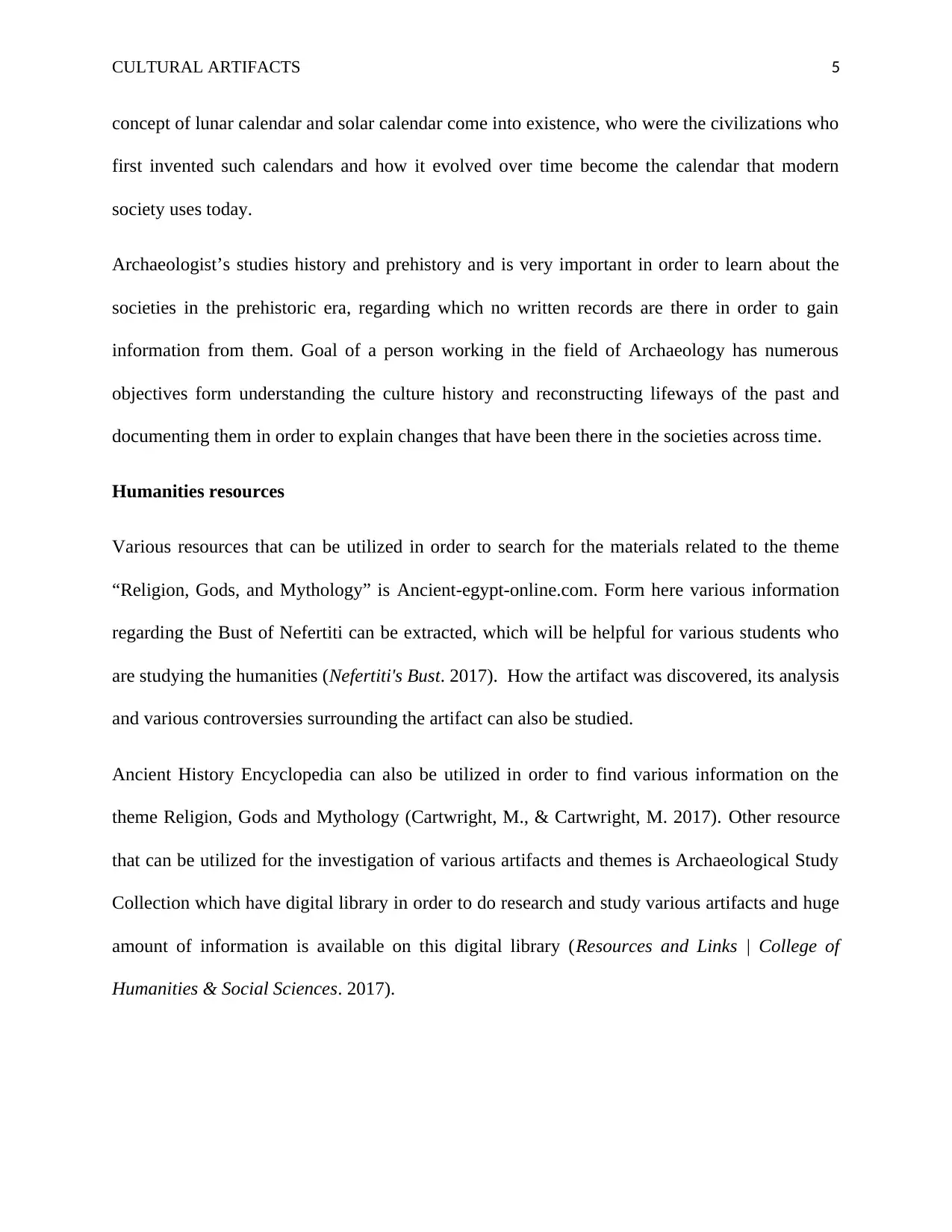
CULTURAL ARTIFACTS 5
concept of lunar calendar and solar calendar come into existence, who were the civilizations who
first invented such calendars and how it evolved over time become the calendar that modern
society uses today.
Archaeologist’s studies history and prehistory and is very important in order to learn about the
societies in the prehistoric era, regarding which no written records are there in order to gain
information from them. Goal of a person working in the field of Archaeology has numerous
objectives form understanding the culture history and reconstructing lifeways of the past and
documenting them in order to explain changes that have been there in the societies across time.
Humanities resources
Various resources that can be utilized in order to search for the materials related to the theme
“Religion, Gods, and Mythology” is Ancient-egypt-online.com. Form here various information
regarding the Bust of Nefertiti can be extracted, which will be helpful for various students who
are studying the humanities (Nefertiti's Bust. 2017). How the artifact was discovered, its analysis
and various controversies surrounding the artifact can also be studied.
Ancient History Encyclopedia can also be utilized in order to find various information on the
theme Religion, Gods and Mythology (Cartwright, M., & Cartwright, M. 2017). Other resource
that can be utilized for the investigation of various artifacts and themes is Archaeological Study
Collection which have digital library in order to do research and study various artifacts and huge
amount of information is available on this digital library (Resources and Links | College of
Humanities & Social Sciences. 2017).
concept of lunar calendar and solar calendar come into existence, who were the civilizations who
first invented such calendars and how it evolved over time become the calendar that modern
society uses today.
Archaeologist’s studies history and prehistory and is very important in order to learn about the
societies in the prehistoric era, regarding which no written records are there in order to gain
information from them. Goal of a person working in the field of Archaeology has numerous
objectives form understanding the culture history and reconstructing lifeways of the past and
documenting them in order to explain changes that have been there in the societies across time.
Humanities resources
Various resources that can be utilized in order to search for the materials related to the theme
“Religion, Gods, and Mythology” is Ancient-egypt-online.com. Form here various information
regarding the Bust of Nefertiti can be extracted, which will be helpful for various students who
are studying the humanities (Nefertiti's Bust. 2017). How the artifact was discovered, its analysis
and various controversies surrounding the artifact can also be studied.
Ancient History Encyclopedia can also be utilized in order to find various information on the
theme Religion, Gods and Mythology (Cartwright, M., & Cartwright, M. 2017). Other resource
that can be utilized for the investigation of various artifacts and themes is Archaeological Study
Collection which have digital library in order to do research and study various artifacts and huge
amount of information is available on this digital library (Resources and Links | College of
Humanities & Social Sciences. 2017).
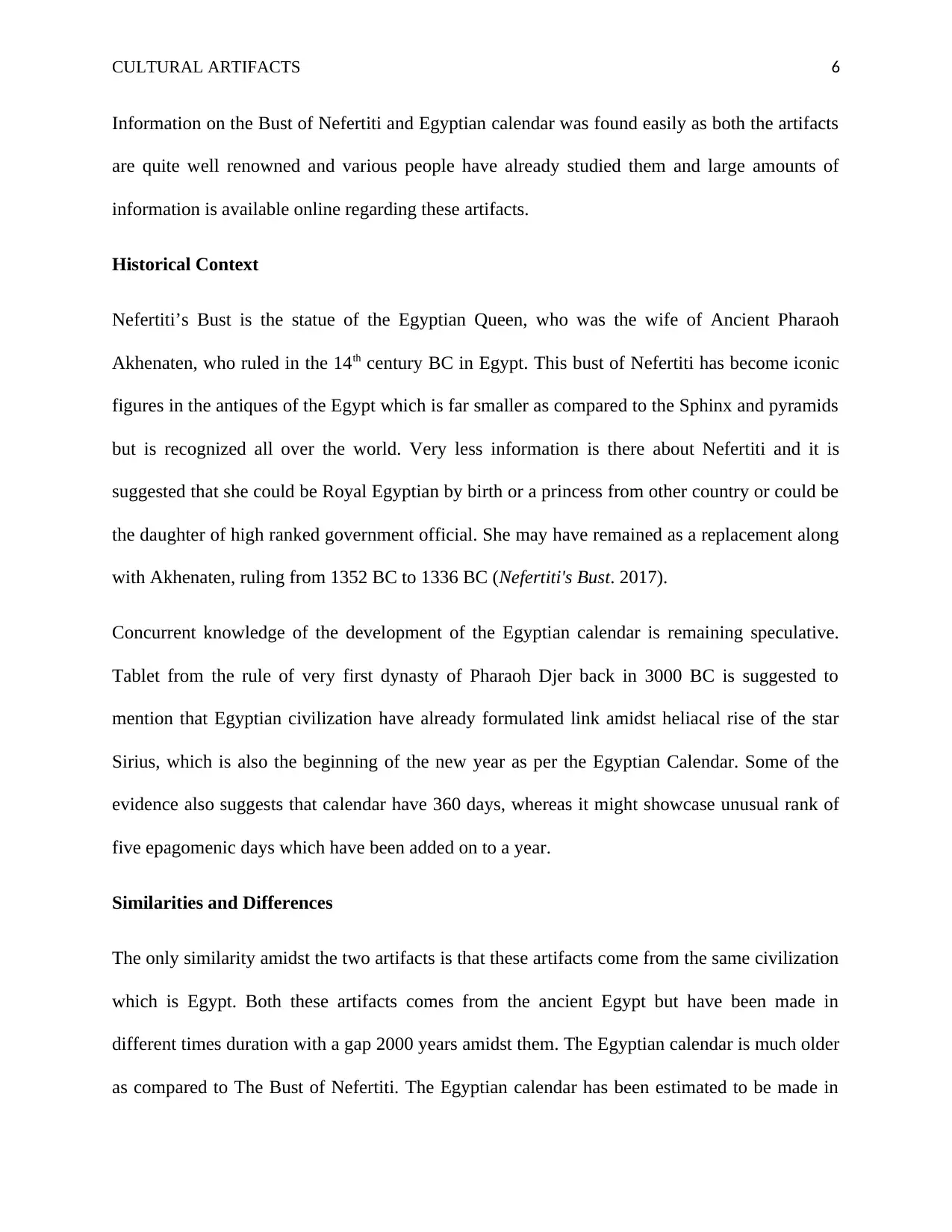
CULTURAL ARTIFACTS 6
Information on the Bust of Nefertiti and Egyptian calendar was found easily as both the artifacts
are quite well renowned and various people have already studied them and large amounts of
information is available online regarding these artifacts.
Historical Context
Nefertiti’s Bust is the statue of the Egyptian Queen, who was the wife of Ancient Pharaoh
Akhenaten, who ruled in the 14th century BC in Egypt. This bust of Nefertiti has become iconic
figures in the antiques of the Egypt which is far smaller as compared to the Sphinx and pyramids
but is recognized all over the world. Very less information is there about Nefertiti and it is
suggested that she could be Royal Egyptian by birth or a princess from other country or could be
the daughter of high ranked government official. She may have remained as a replacement along
with Akhenaten, ruling from 1352 BC to 1336 BC (Nefertiti's Bust. 2017).
Concurrent knowledge of the development of the Egyptian calendar is remaining speculative.
Tablet from the rule of very first dynasty of Pharaoh Djer back in 3000 BC is suggested to
mention that Egyptian civilization have already formulated link amidst heliacal rise of the star
Sirius, which is also the beginning of the new year as per the Egyptian Calendar. Some of the
evidence also suggests that calendar have 360 days, whereas it might showcase unusual rank of
five epagomenic days which have been added on to a year.
Similarities and Differences
The only similarity amidst the two artifacts is that these artifacts come from the same civilization
which is Egypt. Both these artifacts comes from the ancient Egypt but have been made in
different times duration with a gap 2000 years amidst them. The Egyptian calendar is much older
as compared to The Bust of Nefertiti. The Egyptian calendar has been estimated to be made in
Information on the Bust of Nefertiti and Egyptian calendar was found easily as both the artifacts
are quite well renowned and various people have already studied them and large amounts of
information is available online regarding these artifacts.
Historical Context
Nefertiti’s Bust is the statue of the Egyptian Queen, who was the wife of Ancient Pharaoh
Akhenaten, who ruled in the 14th century BC in Egypt. This bust of Nefertiti has become iconic
figures in the antiques of the Egypt which is far smaller as compared to the Sphinx and pyramids
but is recognized all over the world. Very less information is there about Nefertiti and it is
suggested that she could be Royal Egyptian by birth or a princess from other country or could be
the daughter of high ranked government official. She may have remained as a replacement along
with Akhenaten, ruling from 1352 BC to 1336 BC (Nefertiti's Bust. 2017).
Concurrent knowledge of the development of the Egyptian calendar is remaining speculative.
Tablet from the rule of very first dynasty of Pharaoh Djer back in 3000 BC is suggested to
mention that Egyptian civilization have already formulated link amidst heliacal rise of the star
Sirius, which is also the beginning of the new year as per the Egyptian Calendar. Some of the
evidence also suggests that calendar have 360 days, whereas it might showcase unusual rank of
five epagomenic days which have been added on to a year.
Similarities and Differences
The only similarity amidst the two artifacts is that these artifacts come from the same civilization
which is Egypt. Both these artifacts comes from the ancient Egypt but have been made in
different times duration with a gap 2000 years amidst them. The Egyptian calendar is much older
as compared to The Bust of Nefertiti. The Egyptian calendar has been estimated to be made in
Secure Best Marks with AI Grader
Need help grading? Try our AI Grader for instant feedback on your assignments.
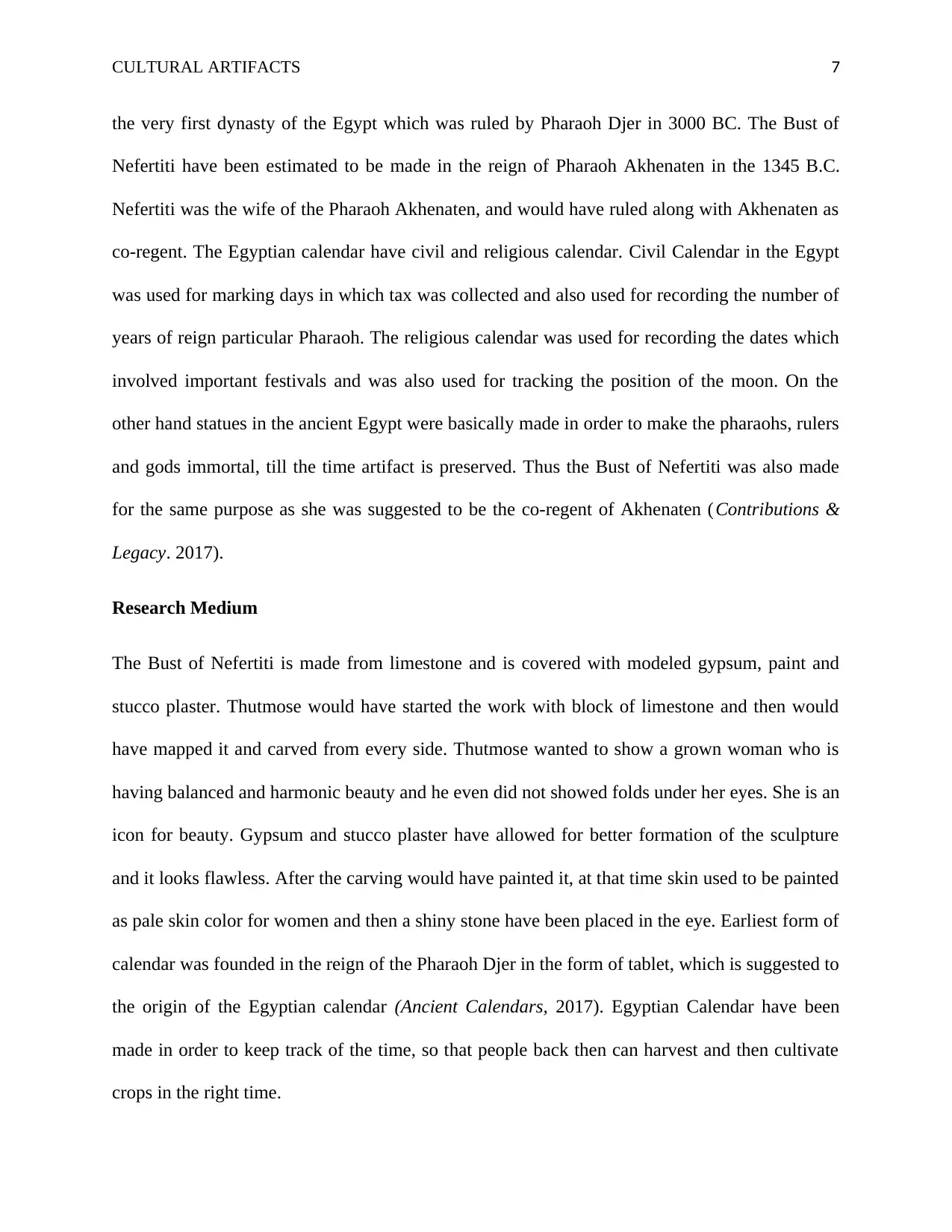
CULTURAL ARTIFACTS 7
the very first dynasty of the Egypt which was ruled by Pharaoh Djer in 3000 BC. The Bust of
Nefertiti have been estimated to be made in the reign of Pharaoh Akhenaten in the 1345 B.C.
Nefertiti was the wife of the Pharaoh Akhenaten, and would have ruled along with Akhenaten as
co-regent. The Egyptian calendar have civil and religious calendar. Civil Calendar in the Egypt
was used for marking days in which tax was collected and also used for recording the number of
years of reign particular Pharaoh. The religious calendar was used for recording the dates which
involved important festivals and was also used for tracking the position of the moon. On the
other hand statues in the ancient Egypt were basically made in order to make the pharaohs, rulers
and gods immortal, till the time artifact is preserved. Thus the Bust of Nefertiti was also made
for the same purpose as she was suggested to be the co-regent of Akhenaten (Contributions &
Legacy. 2017).
Research Medium
The Bust of Nefertiti is made from limestone and is covered with modeled gypsum, paint and
stucco plaster. Thutmose would have started the work with block of limestone and then would
have mapped it and carved from every side. Thutmose wanted to show a grown woman who is
having balanced and harmonic beauty and he even did not showed folds under her eyes. She is an
icon for beauty. Gypsum and stucco plaster have allowed for better formation of the sculpture
and it looks flawless. After the carving would have painted it, at that time skin used to be painted
as pale skin color for women and then a shiny stone have been placed in the eye. Earliest form of
calendar was founded in the reign of the Pharaoh Djer in the form of tablet, which is suggested to
the origin of the Egyptian calendar (Ancient Calendars, 2017). Egyptian Calendar have been
made in order to keep track of the time, so that people back then can harvest and then cultivate
crops in the right time.
the very first dynasty of the Egypt which was ruled by Pharaoh Djer in 3000 BC. The Bust of
Nefertiti have been estimated to be made in the reign of Pharaoh Akhenaten in the 1345 B.C.
Nefertiti was the wife of the Pharaoh Akhenaten, and would have ruled along with Akhenaten as
co-regent. The Egyptian calendar have civil and religious calendar. Civil Calendar in the Egypt
was used for marking days in which tax was collected and also used for recording the number of
years of reign particular Pharaoh. The religious calendar was used for recording the dates which
involved important festivals and was also used for tracking the position of the moon. On the
other hand statues in the ancient Egypt were basically made in order to make the pharaohs, rulers
and gods immortal, till the time artifact is preserved. Thus the Bust of Nefertiti was also made
for the same purpose as she was suggested to be the co-regent of Akhenaten (Contributions &
Legacy. 2017).
Research Medium
The Bust of Nefertiti is made from limestone and is covered with modeled gypsum, paint and
stucco plaster. Thutmose would have started the work with block of limestone and then would
have mapped it and carved from every side. Thutmose wanted to show a grown woman who is
having balanced and harmonic beauty and he even did not showed folds under her eyes. She is an
icon for beauty. Gypsum and stucco plaster have allowed for better formation of the sculpture
and it looks flawless. After the carving would have painted it, at that time skin used to be painted
as pale skin color for women and then a shiny stone have been placed in the eye. Earliest form of
calendar was founded in the reign of the Pharaoh Djer in the form of tablet, which is suggested to
the origin of the Egyptian calendar (Ancient Calendars, 2017). Egyptian Calendar have been
made in order to keep track of the time, so that people back then can harvest and then cultivate
crops in the right time.
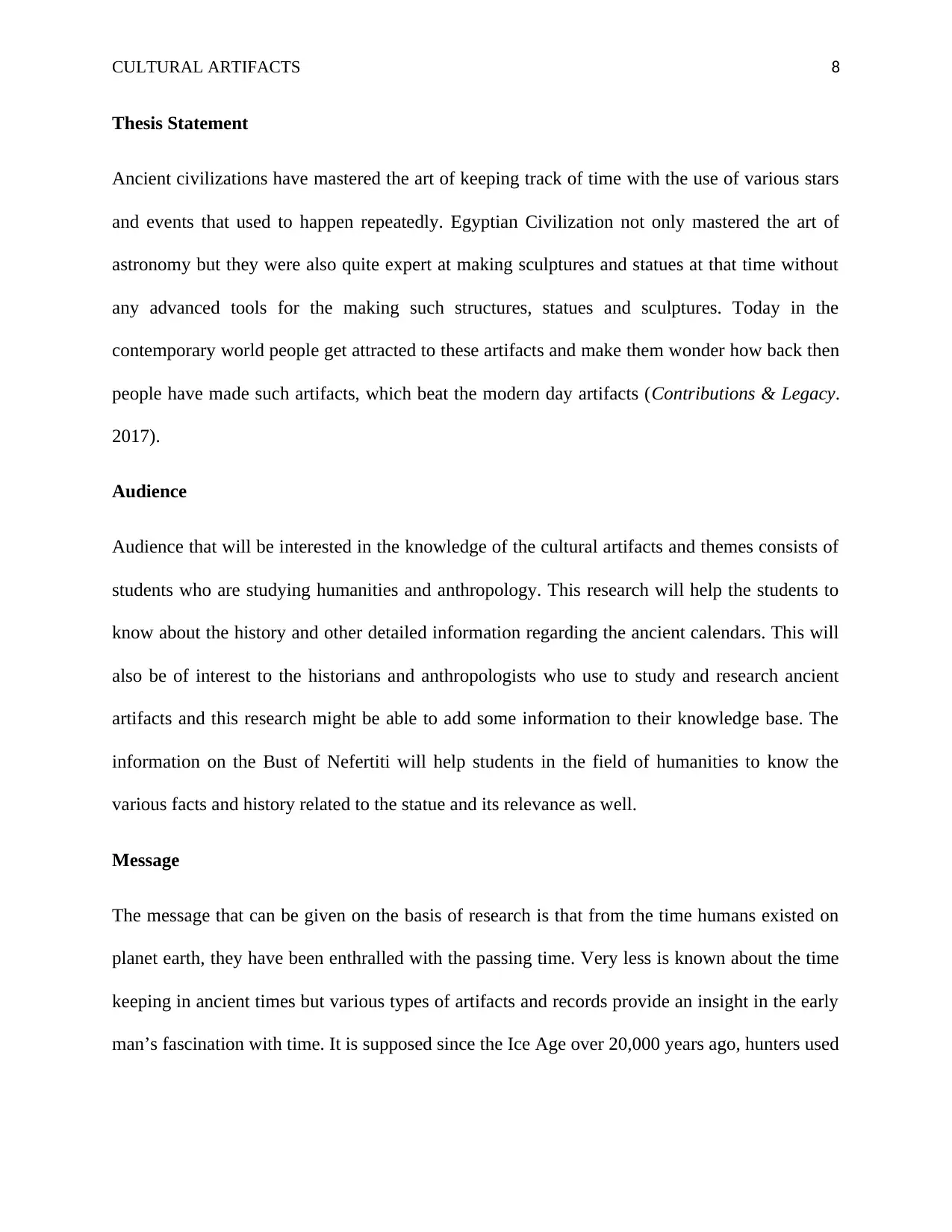
CULTURAL ARTIFACTS 8
Thesis Statement
Ancient civilizations have mastered the art of keeping track of time with the use of various stars
and events that used to happen repeatedly. Egyptian Civilization not only mastered the art of
astronomy but they were also quite expert at making sculptures and statues at that time without
any advanced tools for the making such structures, statues and sculptures. Today in the
contemporary world people get attracted to these artifacts and make them wonder how back then
people have made such artifacts, which beat the modern day artifacts (Contributions & Legacy.
2017).
Audience
Audience that will be interested in the knowledge of the cultural artifacts and themes consists of
students who are studying humanities and anthropology. This research will help the students to
know about the history and other detailed information regarding the ancient calendars. This will
also be of interest to the historians and anthropologists who use to study and research ancient
artifacts and this research might be able to add some information to their knowledge base. The
information on the Bust of Nefertiti will help students in the field of humanities to know the
various facts and history related to the statue and its relevance as well.
Message
The message that can be given on the basis of research is that from the time humans existed on
planet earth, they have been enthralled with the passing time. Very less is known about the time
keeping in ancient times but various types of artifacts and records provide an insight in the early
man’s fascination with time. It is supposed since the Ice Age over 20,000 years ago, hunters used
Thesis Statement
Ancient civilizations have mastered the art of keeping track of time with the use of various stars
and events that used to happen repeatedly. Egyptian Civilization not only mastered the art of
astronomy but they were also quite expert at making sculptures and statues at that time without
any advanced tools for the making such structures, statues and sculptures. Today in the
contemporary world people get attracted to these artifacts and make them wonder how back then
people have made such artifacts, which beat the modern day artifacts (Contributions & Legacy.
2017).
Audience
Audience that will be interested in the knowledge of the cultural artifacts and themes consists of
students who are studying humanities and anthropology. This research will help the students to
know about the history and other detailed information regarding the ancient calendars. This will
also be of interest to the historians and anthropologists who use to study and research ancient
artifacts and this research might be able to add some information to their knowledge base. The
information on the Bust of Nefertiti will help students in the field of humanities to know the
various facts and history related to the statue and its relevance as well.
Message
The message that can be given on the basis of research is that from the time humans existed on
planet earth, they have been enthralled with the passing time. Very less is known about the time
keeping in ancient times but various types of artifacts and records provide an insight in the early
man’s fascination with time. It is supposed since the Ice Age over 20,000 years ago, hunters used
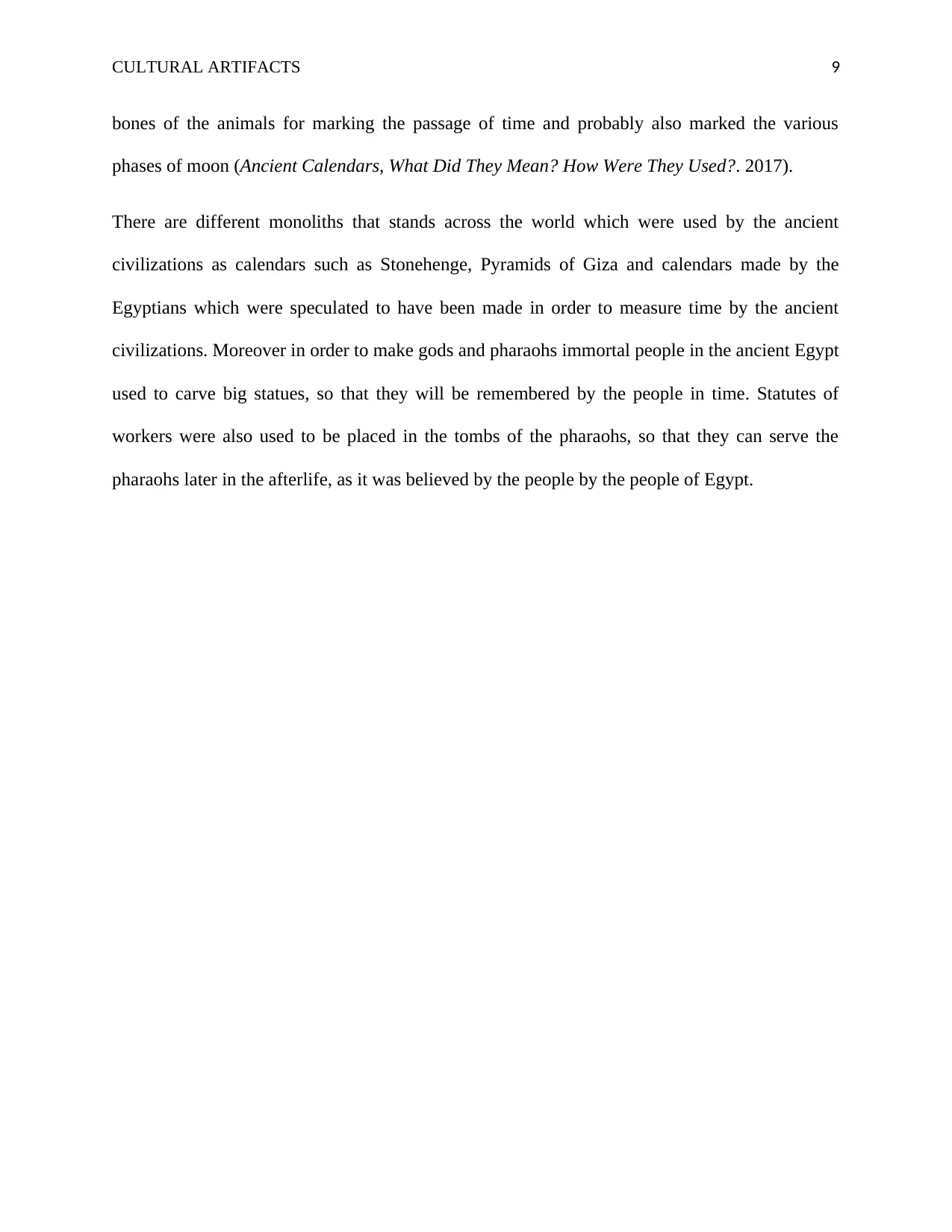
CULTURAL ARTIFACTS 9
bones of the animals for marking the passage of time and probably also marked the various
phases of moon (Ancient Calendars, What Did They Mean? How Were They Used?. 2017).
There are different monoliths that stands across the world which were used by the ancient
civilizations as calendars such as Stonehenge, Pyramids of Giza and calendars made by the
Egyptians which were speculated to have been made in order to measure time by the ancient
civilizations. Moreover in order to make gods and pharaohs immortal people in the ancient Egypt
used to carve big statues, so that they will be remembered by the people in time. Statutes of
workers were also used to be placed in the tombs of the pharaohs, so that they can serve the
pharaohs later in the afterlife, as it was believed by the people by the people of Egypt.
bones of the animals for marking the passage of time and probably also marked the various
phases of moon (Ancient Calendars, What Did They Mean? How Were They Used?. 2017).
There are different monoliths that stands across the world which were used by the ancient
civilizations as calendars such as Stonehenge, Pyramids of Giza and calendars made by the
Egyptians which were speculated to have been made in order to measure time by the ancient
civilizations. Moreover in order to make gods and pharaohs immortal people in the ancient Egypt
used to carve big statues, so that they will be remembered by the people in time. Statutes of
workers were also used to be placed in the tombs of the pharaohs, so that they can serve the
pharaohs later in the afterlife, as it was believed by the people by the people of Egypt.
Paraphrase This Document
Need a fresh take? Get an instant paraphrase of this document with our AI Paraphraser

CULTURAL ARTIFACTS 10
References
Alan E. S. (9 August 2017). Britannica.com. Retrieved from
https://www.britannica.com/science/Egyptian-calendar
John R. B. (9 August 2017). Infoplease.com. Retrieved from
https://www.infoplease.com/calendar-holidays/calendars/history-egyptian-calendar
Cartwright, M., & Cartwright, M. (2017). Sun Stone. Ancient History Encyclopedia. Retrieved 9
August 2017, from http://www.ancient.eu/Sun_Stone/
Ancient Calendars, What Did They Mean? How Were They Used?.
(2017). Educatinghumanity.com. Retrieved 9 August 2017, from
http://www.educatinghumanity.com/2012/12/Ancient-Calendars-Mayans-Zodiac-Signs-End-
Times-Astrology-Prediction.html
Resources and Links | College of Humanities & Social Sciences. (2017). Chss.wwu.edu.
Retrieved 9 August 2017, from https://chss.wwu.edu/anthropology/resources-and-links
Contributions & Legacy. (2017). Welcome to Ancient Egypt!. Retrieved 9 August 2017, from
http://ancient-egypt-by-us.weebly.com/contributions--legacy.html
e.V., V. (2017). Nefertiti: (Society for the Promotion of the Egyptian Museum Berlin). Egyptian-
museum-berlin.com. Retrieved 11 August 2017, from
http://www.egyptian-museum-berlin.com/c53.php
Untitled Document. (2017). Caitloon.com. Retrieved 11 August 2017, from
http://www.caitloon.com/sculpture.html
References
Alan E. S. (9 August 2017). Britannica.com. Retrieved from
https://www.britannica.com/science/Egyptian-calendar
John R. B. (9 August 2017). Infoplease.com. Retrieved from
https://www.infoplease.com/calendar-holidays/calendars/history-egyptian-calendar
Cartwright, M., & Cartwright, M. (2017). Sun Stone. Ancient History Encyclopedia. Retrieved 9
August 2017, from http://www.ancient.eu/Sun_Stone/
Ancient Calendars, What Did They Mean? How Were They Used?.
(2017). Educatinghumanity.com. Retrieved 9 August 2017, from
http://www.educatinghumanity.com/2012/12/Ancient-Calendars-Mayans-Zodiac-Signs-End-
Times-Astrology-Prediction.html
Resources and Links | College of Humanities & Social Sciences. (2017). Chss.wwu.edu.
Retrieved 9 August 2017, from https://chss.wwu.edu/anthropology/resources-and-links
Contributions & Legacy. (2017). Welcome to Ancient Egypt!. Retrieved 9 August 2017, from
http://ancient-egypt-by-us.weebly.com/contributions--legacy.html
e.V., V. (2017). Nefertiti: (Society for the Promotion of the Egyptian Museum Berlin). Egyptian-
museum-berlin.com. Retrieved 11 August 2017, from
http://www.egyptian-museum-berlin.com/c53.php
Untitled Document. (2017). Caitloon.com. Retrieved 11 August 2017, from
http://www.caitloon.com/sculpture.html

CULTURAL ARTIFACTS 11
Nefertiti's Bust. (2017). Ancient-egypt-online.com. Retrieved 11 August 2017, from
http://www.ancient-egypt-online.com/nefertiti-bust.html
What Were the Themes of Egyptian Art? | Synonym. (2017). Classroom.synonym.com. Retrieved
13 August 2017, from http://classroom.synonym.com/were-themes-egyptian-art-8655120.html
Nefertiti's Bust. (2017). Ancient-egypt-online.com. Retrieved 11 August 2017, from
http://www.ancient-egypt-online.com/nefertiti-bust.html
What Were the Themes of Egyptian Art? | Synonym. (2017). Classroom.synonym.com. Retrieved
13 August 2017, from http://classroom.synonym.com/were-themes-egyptian-art-8655120.html
1 out of 12
![[object Object]](/_next/static/media/star-bottom.7253800d.svg)




